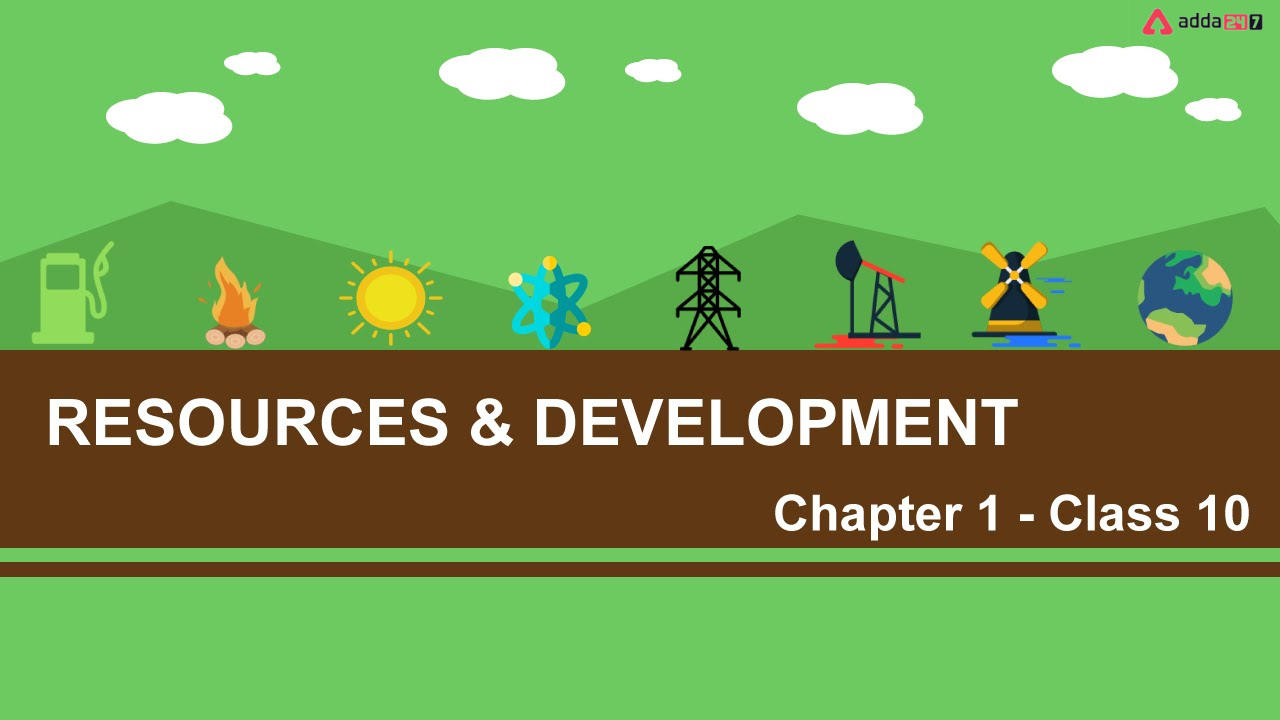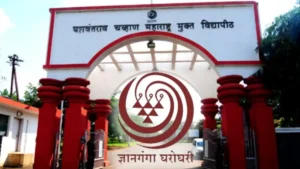Resources and Development Class 10 Notes- What is Resources?
The term “Resources” refers to everything our environment gives us that is practical economically, socially, and technologically.
It creates an interactive relationship between institutions, technology, and nature that helps the economy expand more quickly.
Resources are a part of people since they are used and utilized by people. They belong to the human resources department.
The following criteria can be used to categorize the resources:
(a) By origin, both biotic and abiotic
(b) Based on renewable and non-renewable resources’ exhaustibility.
(c) Depending on who owns it: privately or publicly, locally, nationally, or internationally
(d) In accordance with the development status of the potential, developed stock, and reserves.
On Basis Of Origin
- Biotic: Derived from biospheres; includes fisheries, flora, and fauna, among other things.
- Abiotic: Derived from non-living materials like metals and rocks.
On The Basis Of Exhaustibility
- Renewable
- Once they are depleted, these resources can be replenished.
- Examples include solar and wind energy.
- Non-Renewable
- These materials cannot renew themselves once they are used up. We risk losing them forever if we consume them in full without preparing.
- Minerals and fossil fuels, for instance.
On The Basis Of Ownership
- Individual
- privately owned by individuals
- For instance, plantations and pastureland
II. Community
- These resources are open to all community members.
- Examples include pastures and cemeteries.
III. National
- The country enjoys complete legal autonomy over all of its resources, which are all it’s own.
- The government can purchase private property to further the common good.
- For instance, roads, railroads, etc.
- International
- The open ocean is responsible for the ocean resources located beyond 200 nautical miles of the Exclusive Economic Zone.
- These may not be used by any one nation without prior consent from international organisations.
On The Basis Of The Status Of Development
- Potential
- Potential resources are those that are present in a place but have not yet reached their full potential.
- Example: Wind and solar energy development in Rajasthan and Gujarat has huge potential, but up until now, these resources have not been used effectively.
- Developed
- Developed resources are those whose quality and quantity have been assessed to be used.
- Technology and the degree of their viability determine how much these resources are used.
- An abundant source of energy is hydrogen. But we lack the cutting-edge technology needed to use it.
III. Stock
- Resources that can be utilized in nature but are not currently being used by humans because they lack the necessary tools and technology.
- Example: Hydrogen and oxygen can be extracted from water by breaking it down. Although hydrogen is an excellent energy source, we are unsure how to produce it on a huge scale.
- Reserves
Although human civilization possesses the necessary technology to make use of these resources, further technological advancement is needed to utilize these resources fully.
Example: Hydropower is only produced for a few uses because it is produced from water.
Ace your class 10th board exams with Adda247 live classes for class 10th preparation.
Resources and Development Class 10 Notes- Development Of Resources
Humans have overused resources, which has resulted in the following issues:
- Exploitationtion of resources to feed a small group of people’s greed.
- The concentration of wealth in a small number of hands has led to the emergence of the haves and the have-nots, or the rich and the poor.
- Uncontrolled resource use causes ecological problems around the world, including ozone layer loss, environmental contamination, and land degradation.
Resources and Development Class 10 Notes- Sustainable Development
- Sustainable development is defined as growth that doesn’t overly exploit the environment.
- It focuses on the notion that “the requirements of the future generations should not be compromised by the growth in the present.”
- More than 100 heads of state gathered in Rio de Janeiro, Brazil, for the first International Earth Summit in June 1992, which was a global event.
- The Summit was called to address serious issues with global socioeconomic development and environmental conservation.
- The world’s leaders joined together to issue a declaration on biological diversity and climate change.
- The Rio Convention adopted Agenda 21 for attaining Sustainable Development in the twenty-first century and accepted the global forest principles.
- Its goal was to achieve sustainable development on a global scale.
- The agenda strives to tackle environmental deterioration, poverty, and disease through international cooperation on shared needs, interests, and responsibilities.
- Every local authority should create its own local Agenda 21 is one of the main goals of Agenda 21.
Resources and Development Class 10 Notes-Resource Planning In India
- Since some locations have ample resources while others don’t, planning is the commonly acknowledged method for making wise use of those resources.
- For instance, the mineral- and coal-rich states of Jharkhand, Chhattisgarh, and Madhya Pradesh. Despite having an abundance of water resources, Arunachal Pradesh lacks infrastructure development.
- Rajasthan is exceptionally well-endowed with wind and solar power but lacks water resources.
- Ladakh’s frigid desert is cut off from the rest of the nation. Despite having a very rich cultural past, it lacks certain essential minerals, adequate infrastructure, and access to water.
Resources and Development Class 10 Notes-Land Use Pattern In India
- Physical elements like terrain, climate, and soil types, as well as human factors like population density, technology advancements, and cultural and traditional practices, are used to affect how land is used.
- Additionally, less land is now permanently used for pasture.
- The distribution of net sown area varies significantly between states. In Punjab and Haryana, it makes up more than 80% of the entire area, while in Arunachal Pradesh, Mizoram, Manipur, and the Andaman Nicobar Islands, it makes up less than 10%.
- The country’s forest area is much less than the targeted 33 percent of the country’s land area, as specified in the National Forest Policy (1952).
- A portion of the land is designated as wasteland and is used for purposes other than agriculture.
- Rocky, dry, and desert regions are included in the wasteland. Land used for communities, roads, railroads, industries, etc. island that is not used for agriculture.
Resources and Development Class 10 Notes-Degradation Of The Land And Conservation Efforts
The land has started to degrade recently as a result of human activity and some natural events. The pace of land degradation has dramatically increased as a result of some activities, including overgrazing, mining, quarrying, and deforestation. Additionally, industrial waste has harmed the quality of the land, particularly in regions with industrial belts. Our natural resources’ water quality has been impacted by land degradation.
We can take certain steps to protect our land and ensure the land degradation rate slows down, such as limiting mining operations, properly disposing of industrial waste, planting shelterbelts, etc.
Resources and Development Class 10 Notes- Soil As A Resource
One of the valuable renewable natural resources is soil. Every centimeter of soil is formed over the course of millions of years. Temperature, the operation of flowing water, wind, glaciers, the activity of decomposers, parent rock, chemical, and organic changes, etc., are only a few of the variables that affect how soil is formed.
Resources and Development Class 10 Notes-Soil Classification
Due to a variety of natural circumstances, India has several varieties of soil, each with its own thickness, colour, texture, chemical make-up, and physical characteristics.
Alluvial Soils
The soil of the Northern Plains is alluvial. Deposits from the Himalayan rivers Indus, Ganga, and Brahmaputra result in the formation of alluvial soil.
It primarily comprises of clay, silt, and sand. Old alluvial soils, also known as “Bhangar,” and young alluvial soils, also known as “khadar,” are divided based on age.
Black Soil
Cotton crops are renowned for flourishing on the black soil. It is made of lava and is primarily found in the Deccan trap. It has more clay and is renowned for its ability to hold moisture.
Yellow And Red Soils
Areas with less rainfall are more likely to have this sort of soil. The soil is reddish because it contains iron and is made of igneous rock. When the soil is moistened, its colour changes from red to yellow.
Laterite Soil
Acidic laterite soil is found primarily in the southern States of Maharashtra and originates in tropical and subtropical climates where high rainfall causes significant leaching. In order to develop tea and coffee, it is highly beneficial.
Arid Soil
In general, soil lacks humus and moisture and is sandy and salty in nature. As you dig deeper, the soil turns from red to brown and has a high calcium concentration.
Forest Soil
Specifically in the hills and mountains, where the soil is loamy and silty, as well as on the upper slopes, this is found. It has a low humus content and is acidic in nature.
Watching Adda247 YouTube video on this chapter will help you learn more. /
Conservation Of The Soil And Soil Erosion
Both natural and human activity can cause soil erosion. As high soil erosion will result in numerous issues, it needs to be controlled. By employing soil conservation techniques, soil erosion can be reduced.
Resources and Development Class 10 Notes- Various Techniques For Soil Conservation
There are several ways to preserve soil, some of them are as follows:
- Plowing along contours to prevent water from flowing directly down slopes.
- Terrace farming is a practise that prevents soil erosion and promotes soil preservation.
- To reduce erosion, the practise of “strip farming” involves growing strips of grass between the crops.
- Trees are arranged in rows as part of the shelterbelt technique to reduce desert shifting and break the wind.
Resources and Development Class 10 Notes-Sample Questions with Answers
1 Marks Question
Ques. Write two types of renewable resources and give one example of each type.
Ans: Two types of renewable resources are as follows:
- Continuous or Flow Resources, e.g., wind and water resources.
- Biological Resources, e.g., natural vegetation (forests) and wildlife.
Ques. What do you understand by a ‘Resource’? Give examples.
Ans: Everything available in our environment which can be used to satisfy our needs, is called a resource. It should be technologically accessible, economically feasible and culturally acceptable. Only then, it can be termed as a ‘Resource’.
Examples are: minerals, forests, fossil fuels etc..
2 Marks Question
Ques. What types of soil erosion are there?
Ans: The following categories of soil erosion exist:
- Gully Erosion: Gully erosion occurs when water flows through clayey soils, creating deep channels known as gullies that render the land unsuitable for cultivation and referred to as “bad land.”
- Sheet Erosion: Water may occasionally flow across vast areas as a sheet down a hill. The top soil gets washed away in these circumstances. Sheet erosion is the term for this.
- Wind Erosion: The term “wind erosion” refers to the process whereby the top, fertile layer of soil is eroded by the wind. Tree planting helps lessen soil erosion caused by wind.
Ques. “India has enormous diversity in the availability of resources.” Name four varied regions to justify this statement.
Ans: There are regions which are rich or self-sufficient in certain types of resources and there are areas that are deficient or have acute shortage of some vital resources.
For example:-
- The states of Jharkhand, Chhattisgarh and Madhya Pradesh are rich in minerals and coal deposits.
- Arunachal Pradesh has abundance of water resources but lacks in infrastructural development.
- Rajasthan is very well endowed with solar and wind energy but lacks in water resources.
- The cold desert area of Ladakh has very rich cultural heritage. It is deficient in water, infrastructure and some vital minerals.
- Such cases call for balanced resource planning at different levels.
3 Marks Question
Ques. Mention the factors that determine land use in India.
Ans: The use of land is determined both by physical factors such as topography, climate, soil types as well as human factors such as population density, technological capability and culture and traditions. The land under permanent pasture has also decreased.
The pattern of net sown area varies greatly from one state to another. It is over 80 per cent of the total area in Punjab and Haryana and less than 10 per cent in Arunachal Pradesh, Mizoram, Manipur and Andaman Nicobar Islands.
Forest area in the country is far lower than the desired 33 per cent of geographical area, which was stated in the National Forest Policy (1952). A part of the land is termed as waste land and land put to other non-agricultural uses.
Waste land includes rocky, arid and desert areas and land put to other non-agricultural uses includes settlements, roads, railways, industry etc.
Ques. Explain briefly about the ‘Agenda 21’?
Ans: Rio de Janeiro Earth Summit, held in June 1992 was a global submit where more than 100 heads of states met in Rio de Janeiro in Brazil, for the first International Earth Summit. The Summit was convened for addressing urgent problems of environmental protection and socioeconomic development at the global level. A declaration was signed by the global leaders on Global Climatic Change and Biological Diversity. The Rio Convention endorsed the global Forest Principles and adopted Agenda 21 for achieving Sustainable Development in the 21st century. It is aimed at achieving global sustainable development.
It is an agenda that aims at combating environmental damage, poverty, disease through global co-operation on common interests, mutual needs and shared responsibilities. One major objective of the Agenda 21 is that every local government should draw its own local Agenda 21.
5 Marks Question
Ques. “Resource planning is essential for sustainable development.” Elaborate
Ans: Planning is the widely accepted strategy for judicious use of resources as there are certain areas that have sufficient resources while others don’t have enough.
For example, the states of Jharkhand, Chhattisgarh and Madhya Pradesh are rich in minerals and coal deposits. Arunachal Pradesh has an abundance of water resources but lacks in infrastructural development. The state of Rajasthan is very well endowed with solar and wind energy but lacks in water resources. The cold desert of Ladakh is isolated from the rest of the country. It has an extraordinarily rich cultural heritage but it is deficient in water, infrastructure, and some vital minerals.
Resource planning is a complex process that involves:
(i) Identification and inventory of resources across the regions of the country. This involves surveying, mapping and qualitative and quantitative estimation and measurement of the resources.
(ii) Evolving a planning structure endowed with appropriate technology, skill and institutional set up for implementing resource development plans.
(iii) Matching the resource development plans with overall national development plans.
Ques. What is meant by land degradation? Write five human activities which are mainly responsible for land degradation in India.
Ans: Land degradation is a process through which the land becomes unsuitable for agricultural activities. The following human activities are responsible for land degradation:
(i) Mining: Mining sites are abandoned after excavation work is complete leaving deep scars and traces of over burdening. In states like Jharkhand, Chhattisgarh, Madhya Pradesh and Odisha deforestation due to mining have caused severe land degradation.
(ii) Overgrazing: Overgrazing occurs when plants are exposed to intensive grazing for extended periods of time, or without sufficient recovery periods. In states like Gujarat, Rajasthan, Madhya Pradesh and Maharashtra overgrazing is one of the main reasons for land degradation.
(iii) Over irrigation: In states of Punjab, Haryana and western Uttar Pradesh, over irrigation is responsible for land degradation. It occurs due to water logging that leads to increase in salinity and alkalinity in the soil.
(iv) Mineral processing: The mineral processing like grinding of limestone for cement industry and calcite and soapstone for ceramic industry generate huge quantity of dust in the atmosphere. It retards the process of infiltration of water into the soil after it settles down on the land.
(v) Industrial effluents as waste have also become a major source of land degradation in many parts of the country.









 DTE Maharashtra Polytechnic Merit List 2...
DTE Maharashtra Polytechnic Merit List 2...
 JEECUP Round 2 Seat Allotment Result 202...
JEECUP Round 2 Seat Allotment Result 202...
 YCMOU Result 2025 Out @ycmou.digitaluniv...
YCMOU Result 2025 Out @ycmou.digitaluniv...

